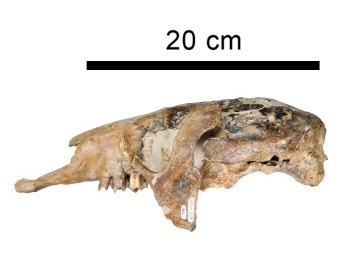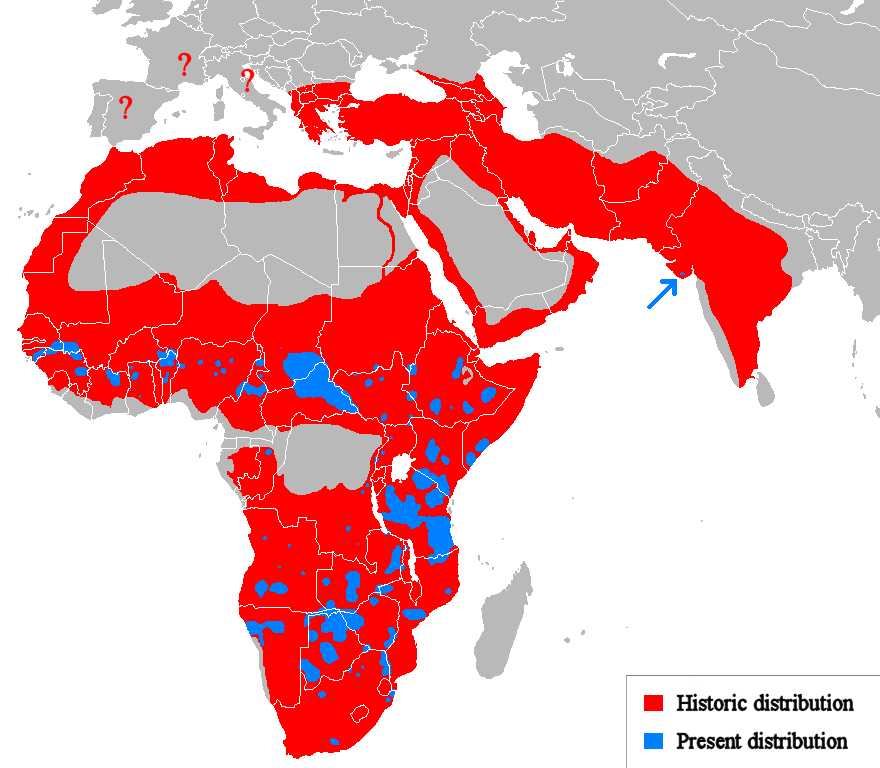|
Chronospecies
A chronospecies is a species derived from a sequential development pattern that involves continual and uniform changes from an extinct ancestral form on an evolutionary scale. The sequence of alterations eventually produces a population that is physically, morphologically, and/or genetically distinct from the original ancestors. Throughout the change, there is only one species in the lineage at any point in time, as opposed to cases where divergent evolution produces contemporary species with a common ancestor. The related term paleospecies (or palaeospecies) indicates an extinct species only identified with fossil material. That identification relies on distinct similarities between the earlier fossil specimens and some proposed descendant although the exact relationship to the later species is not always defined. In particular, the range of variation within all the early fossil specimens does not exceed the observed range that exists in the later species. A paleosubspecies (o ... [...More Info...] [...Related Items...] OR: [Wikipedia] [Google] [Baidu] |
Species
A species () is often defined as the largest group of organisms in which any two individuals of the appropriate sexes or mating types can produce fertile offspring, typically by sexual reproduction. It is the basic unit of Taxonomy (biology), classification and a taxonomic rank of an organism, as well as a unit of biodiversity. Other ways of defining species include their karyotype, DNA sequence, morphology (biology), morphology, behaviour, or ecological niche. In addition, palaeontologists use the concept of the chronospecies since fossil reproduction cannot be examined. The most recent rigorous estimate for the total number of species of eukaryotes is between 8 and 8.7 million. About 14% of these had been described by 2011. All species (except viruses) are given a binomial nomenclature, two-part name, a "binomen". The first part of a binomen is the name of a genus to which the species belongs. The second part is called the specific name (zoology), specific name or the specific ... [...More Info...] [...Related Items...] OR: [Wikipedia] [Google] [Baidu] |
Anagenesis
Anagenesis is the gradual evolution of a species that continues to exist as an interbreeding population. This contrasts with cladogenesis, which occurs when branching or splitting occurs, leading to two or more lineages and resulting in separate species. Anagenesis does not always lead to the formation of a new species from an ancestral species. When speciation does occur as different lineages branch off and cease to interbreed, a core group may continue to be defined as the original species. The evolution of this group, without extinction or species selection, is anagenesis. Hypotheses One hypothesis is that during the speciation event in anagenetic evolution, the original populations increases quickly, and then racks up genetic variation over long periods of time by mutation and recombination in a stable environment. Other factors, such as selection or genetic drift will have such a significant effect on genetic material and physical traits that a species can be acknowl ... [...More Info...] [...Related Items...] OR: [Wikipedia] [Google] [Baidu] |
Thalassocnus
''Thalassocnus'' is an extinct genus of semiaquatic ground sloths from the Miocene and Pliocene of the Pacific South American coast. It is monotypic within the subfamily Thalassocninae. The five species—''T. antiquus'', ''T. natans'', ''T. littoralis'', ''T. carolomartini'', and ''T. yuacensis''—represent a chronospecies, a population gradually adapting to marine life in one direct lineage. They are the only known aquatic sloths, but they may have also been adapted to a terrestrial lifestyle. They have been found in the Pisco Formation of Peru, the Tafna Formation of Argentina, and the Bahía Inglesa Formation, Bahía Inglesa, Coquimbo Formation, Coquimbo, and Horcón Formation, Horcón formation (geology), formations of Chile. Thalassocninae has been placed in both the family (biology), families Megatheriidae and Nothrotheriidae. ''Thalassocnus'' evolved several marine adaptations over 4 million years, such as dense and heavy bones to counteract buoyancy, the internal nostri ... [...More Info...] [...Related Items...] OR: [Wikipedia] [Google] [Baidu] |
Stratigraphic
Stratigraphy is a branch of geology concerned with the study of rock layers (strata) and layering (stratification). It is primarily used in the study of sedimentary and layered volcanic rocks. Stratigraphy has three related subfields: lithostratigraphy (lithologic stratigraphy), biostratigraphy (biologic stratigraphy), and chronostratigraphy (stratigraphy by age). Historical development Catholic priest Nicholas Steno established the theoretical basis for stratigraphy when he introduced the law of superposition, the principle of original horizontality and the principle of lateral continuity in a 1669 work on the fossilization of organic remains in layers of sediment. The first practical large-scale application of stratigraphy was by William Smith in the 1790s and early 19th century. Known as the "Father of English geology", Smith recognized the significance of strata or rock layering and the importance of fossil markers for correlating strata; he created the first geo ... [...More Info...] [...Related Items...] OR: [Wikipedia] [Google] [Baidu] |
Evolutionary Biology
Evolutionary biology is the subfield of biology that studies the evolutionary processes such as natural selection, common descent, and speciation that produced the diversity of life on Earth. In the 1930s, the discipline of evolutionary biology emerged through what Julian Huxley called the Modern synthesis (20th century), modern synthesis of understanding, from previously unrelated fields of biological research, such as genetics and ecology, systematics, and paleontology. The investigational range of current research has widened to encompass the genetic architecture of adaptation, molecular evolution, and the different forces that contribute to evolution, such as sexual selection, genetic drift, and biogeography. The newer field of evolutionary developmental biology ("evo-devo") investigates how embryogenesis is controlled, thus yielding a wider synthesis that integrates developmental biology with the fields of study covered by the earlier evolutionary synthesis. Subfields ... [...More Info...] [...Related Items...] OR: [Wikipedia] [Google] [Baidu] |
Orthogenesis
Orthogenesis, also known as orthogenetic evolution, progressive evolution, evolutionary progress, or progressionism, is an Superseded theories in science, obsolete biological hypothesis that organisms have an innate tendency to evolution, evolve in a definite direction teleology, towards some goal (teleology) due to some internal mechanism or "driving force". According to the theory, the largest-scale trends in evolution have an absolute goal such as Evolution of biological complexity, increasing biological complexity. Prominent historical figures who have championed some form of evolutionary progress include Jean-Baptiste Lamarck, Teilhard de Chardin, Pierre Teilhard de Chardin, and Henri Bergson. The term ''orthogenesis'' was introduced by Wilhelm Haacke in 1893 and popularized by Theodor Eimer five years later. Proponents of orthogenesis had rejected the theory of natural selection as the organizing mechanism in evolution for a rectilinear (straight-line) model of directed evo ... [...More Info...] [...Related Items...] OR: [Wikipedia] [Google] [Baidu] |
Priabonian
The Priabonian is, in the ICS's geologic timescale, the latest age or the upper stage of the Eocene Epoch or Series. It spans the time between . The Priabonian is preceded by the Bartonian and is followed by the Rupelian, the lowest stage of the Oligocene. '' Priabona'', an extinct dipteran of Pipunculidae family, is named after Priabonian, the age of deposits from which this insect is known. History and naming The Priabonian Stage was introduced in scientific literature by Ernest Munier-Chalmas and Albert de Lapparent in 1893. The stage is named after the small hamlet of Priabona in the community of Monte di Malo, in the Veneto region of northern Italy. Stratigraphic definition The base of the Priabonian Stage is at the first appearance of calcareous nannoplankton species '' Chiasmolithus oamaruensis'' (which forms the base of nanoplankton biozone NP18). An official GSSP was ratified in 2020, and was placed in the Alano di Piave section in Alano di Piave, Bellu ... [...More Info...] [...Related Items...] OR: [Wikipedia] [Google] [Baidu] |
Valdiviathyris
''Valdiviathyris'' is a genus of craniate brachiopods that has changed little since the Silurian, from when fossils are known. The extant species ''V. quenstedti'' is known from the late Eocene. It was initially known only from the holotype collected from the southern Indian Ocean, near Île Saint-Paul, at a depth of . The specimen is considered to be adolescent and has a thin ( thick) calcareous dorsal valve. This has an irregular conical shape, with the tip (or apex) not coinciding with the middle, and is on the outside only adorned by growth lines. On the inside it has pits (or punctae) that branch into four or five canals further to the outside. More recent specimens have been found near New Zealand. Since no fossils of ''Vadiviathyris'' have yet been found dating between the Silurian and the Eocene, this genus is currently regarded as a Lazarus taxon In paleontology, a Lazarus taxon (plural ''taxa'') is a taxon that disappears for one or more periods from the fossil r ... [...More Info...] [...Related Items...] OR: [Wikipedia] [Google] [Baidu] |
Panthera
''Panthera'' is a genus within the family (biology), family Felidae, and one of two extant genera in the subfamily Pantherinae. It contains the largest living members of the cat family. There are five living species: the jaguar, leopard, lion, snow leopard and tiger. Numerous extinct species are also named, including the Panthera spelaea, cave lion and American lion. Etymology The word derives from Classical Latin , itself from the Ancient Greek (). Characteristics In ''Panthera'' species, the dorsal profile of the skull is flattish or evenly convex. The frontal interOrbit (anatomy), orbital area is not noticeably elevated, and the area behind the elevation is less steeply sloped. The basic Cranial cavity, cranial axis is nearly horizontal. The inner chamber of the Auditory bulla, bullae is large, the outer small. The partition between them is close to the external auditory meatus. The convexly rounded chin is sloping. All ''Panthera'' species have an incompletely ossified h ... [...More Info...] [...Related Items...] OR: [Wikipedia] [Google] [Baidu] |
Gymnogyps
''Gymnogyps'' is a genus of New World vultures in the family Cathartidae. There are five known species in the genus, with only one being extant, the California condor. Fossil species *'' Gymnogyps amplus'' was first described by L. H. Miller in 1911 from a broken tarsometatarsus. The species is the only condor species found in the La Brea Tar Pits' Pit 10, which fossils date to "a Holocene radiocarbon age of 9,000 years." The smaller, modern California condor may have evolved from ''G. amplus''. *'' Gymnogyps howardae'' was described from the Late Pleistocene (Lujanian) asphalt deposits known as the Talara Tar Seeps, near Talara, northwestern Peru. It lived about 126,000-12,000 years ago. *'' Gymnogyps kofordi'' was described based on a right tarsometatarsus. *'' Gymnogyps varonai'' is known from fossils found in the late Pleistocene to early Holocene tar seep deposits in Cuba Cuba, officially the Republic of Cuba, is an island country, comprising the island of Cub ... [...More Info...] [...Related Items...] OR: [Wikipedia] [Google] [Baidu] |
Black Vulture
The black vulture (''Coragyps atratus''), also known as the American black vulture, Mexican vulture, zopilote, urubu, or gallinazo, is a bird in the New World vulture family whose range extends from the southeastern United States to Peru, Central Chile and Uruguay in South America. Although a common and widespread species, it has a somewhat more restricted distribution than its compatriot, the turkey vulture, which breeds well into Canada and all the way south to Tierra del Fuego. It is the only extant member of the genus ''Coragyps'', which is in the family Cathartidae. Despite the similar name and appearance, this species is not closely related to the Eurasian black vulture, an Old World vulture, of the family Accipitridae (which includes raptors like the eagles, hawks, kites, and harriers). For ease of locating animal corpses (their primary source of sustenance), black vultures tend to inhabit relatively open areas with scattered trees, such as chaparral, in additio ... [...More Info...] [...Related Items...] OR: [Wikipedia] [Google] [Baidu] |





